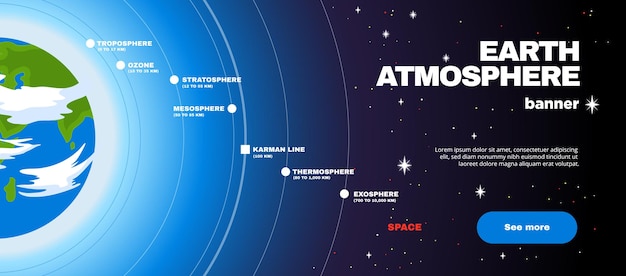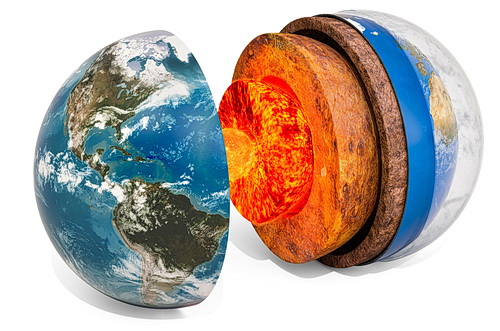
The world above us is more than just the blue sky. There is a whole host of atmospheric layers that make up our atmosphere. Learning about the stratosphere, troposphere, mesosphere, and thermosphere will help you understand these levels better. So let’s get started!
Overview

In the image above, we see the Earth’s inner core, outer core, mantle, upper mantle, crust, and the atmosphere.
The atmosphere can be broken up into several different layers; some of which are further subdivided. The different layers are mainly determined by the wavelength of light measured in each layer. For example, light with a shorter wavelength (blue light) cannot travel as far as light with a longer wavelength (red light).
This article will explore the following topics:
The Troposphere
The troposphere is the first layer of the atmosphere that spans from the Earth’s surface to about 10-18 kilometers. This is where most weather phenomena occur, such as rainfall, thunderstorms, and dust storms. The air temperature in this layer is fairly constant and rarely drops below -40 degrees Celsius or rises above 40 degrees Celsius. This is because the Sun’s radiation is blocked by the Earth’s surface, preventing it from heating the layer above.
The rate at which the temperature of the atmosphere changes depends on latitude and altitude. The troposphere is thicker at the equator than it is at the poles. Also, it is thicker in the summer than it is in the winter. The troposphere is where water vapor and carbon dioxide are found in large amounts. Water vapor is responsible for the formation of clouds and fog. Carbon dioxide is known to be a greenhouse gas and is responsible for global warming.
The Stratosphere
The stratosphere is the second-highest layer of the atmosphere. It covers a large area extending from 10-36 kilometers above the Earth’s surface. The upper boundary of the stratosphere depends on latitude due to the variation in the amount of incoming energy that causes temperature anomalies in the region.
The temperature of the stratosphere is fairly constant. This is because the Sun’s radiation is being reflected back towards space by the molecules of Nitrogen and Oxygen in this layer. This is why temperatures don’t rise above -80° C up to 15 kilometers above the Earth’s surface.
The stratosphere is the layer of the atmosphere that is most affected by ultraviolet (UV) radiation from the sun. In this layer, UV radiation is absorbed by ozone molecules, turning them into oxygen radicals. These then react with Carbon Dioxide, forming Trioxynitrous Acid (CNO). This reaction produces Ozone, which is found in the highest concentrations between 7-15 kilometers above the Earth’s surface.
The Mesosphere
The mesosphere is the third layer of the atmosphere. It is a transition layer that lies between the troposphere and the thermosphere. The upper boundary of the mesosphere is 65-80 kilometers above the Earth’s surface. The lower boundary of the mesosphere is the tropopause, which is the dividing line between the troposphere and the mesosphere.
The mesosphere is very dry, and the air pressure is very low. Temperatures in this layer are between -90 degrees Celsius and -50 degrees Celsius. The mesosphere is constantly being heated by the Sun’s radiation. The thermal energy present in this layer causes it to expand and regularly contract throughout the day.
The Thermosphere
The thermosphere is the fourth layer of the atmosphere. It is the highest layer above the Earth’s surface. This layer is mainly made up of the ionosphere, which runs above it. The upper boundary of the thermosphere is about 500-1,000 kilometers above the Earth’s surface.
The thermosphere is made up of ionized gas at extremely high temperatures – up to 1,800 degrees Celsius. The extremely high temperatures of this layer are due to the Sun’s ultraviolet radiation and the release of energy from the tops of thunderstorms. The ionized gas in this layer is what causes the auroras and the glowing of the polar regions. It also shields the Earth’s surface from the harmful effects of radiation. The existence of ozone in this layer protects us from the harmful effects of ultraviolet rays.
The Existence of Ozone in the Thermosphere
Due to the extremely high temperatures in the thermosphere, ozone is broken down into Oxygen and Oxygen Radicals when it comes in contact with Hydrogen. However, when ultraviolet radiation from the Sun enters the thermosphere, it collides with different atoms (such as Nitrogen and Oxygen). When this happens, it produces Hydrogen. This Hydrogen then collides with the Oxygen Radicals and combines with them to produce Oxygen. When the Oxygen reacts with the broken ozone molecules, it is transformed into Ozone again.
This Ozone is transported by winds towards the Earth’s surface and is responsible for the formation of the ozone layer on the Earth’s surface.
Conclusion
The world above us is more than just the blue sky. There is a whole host of atmospheric layers that make up our atmosphere. Learning about the stratosphere, troposphere, mesosphere, and thermosphere will help you understand these levels better.
